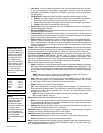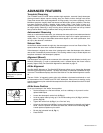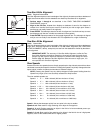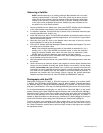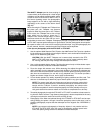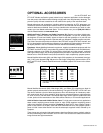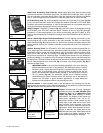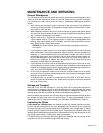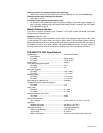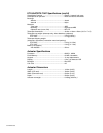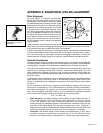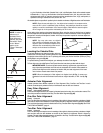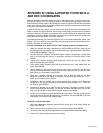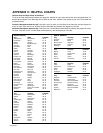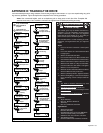
Troubleshooting
The following suggestions may be helpful with operation of the ETX-60AT or ETX-70AT.
The power indicator light on the telescope does not come on or there is no response
when pressing Autostar Arrow keys:
• Verify that the Computer Control Panel power switch (10C, Fig. 1) is in the ON position.
• Verify that the Autostar cord (4, Fig. 3) is firmly connected to the HBX port (10A, Fig. 1).
• Verify that the batteries are installed correctly and that they have sufficient charge. See
“HOW TO ASSEMBLE YOUR TELESCOPE,” page 10.
NOTE: If the batteries are getting low on charge, there will be a marked difference
in the slew speed. The speed indicator lights may also flash and the speed may
change. If any of these symptoms occur, turn the power off and replace the batter-
ies.
• If Autostar does not respond to commands, set the Computer Control Panel power switch
to OFF and then back to ON.
• If the telescope does not slew after power is applied or if the motor quits or stalls, verify
that there are no physical obstructions that would impede telescope movement.
• If all physical obstacles are removed and the telescope still does not move properly, turn
off the power and unplug Autostar. Plug the Autostar back in and turn the power back on.
Unable to see an image through the eyepiece:
• Confirm that the dust cap has been removed from the telescope.
• Confirm that the flip-mirror control (15, Fig. 1) is in the “up” position (Fig. 2a) if using the
eyepiece holder (
3, Fig. 1) so that light is directed to the eyepiece (1, Fig. 1). Confirm that
the flip-mirror control is in the “down” position (Fig. 2b) if using the #933 Erecting Prism or
performing photography with the ETX-60AT or ETX-70AT. See “TELESCOPE FEA-
TURES,” page 4 and “PHOTOGRAPHY WITH THE ETX,” page 23.
Slew speed does not change when the Speed/? key is pressed, or the telescope moves
slowly even though the fast slew speed is chosen:
•
The battery power may be low. See “HOW TO ASSEMBLE YOUR TELESCOPE,” page 10.
Images through the eyepiece appear unfocused or distorted:
• The magnification used may be too high for the seeing conditions. Back off to a lower
power eyepiece. See “TOO MUCH POWER?,” page 11.
• If inside a warm house or building, move outside. Interior air conditions may distort ter-
restrial or celestial images, making it difficult, if not impossible, to obtain a sharp focus. For
optimal viewing, use the telescope outside in the open air instead of observing through an
open or closed window or screen.
• If viewing a land object on a warm day, heat waves distort the image. See “TERRESTRIAL
OBSERVING,” page 21.
• For clear viewing of objects, turn the focus knob (
8, Fig. 1) slowly since the “in-focus” point
of a telescope is precise. Turning the focus knob too quickly may cause the focus point to
pass without notice.
• The optics within the telescope need time to adjust to the outside ambient temperature to
provide the sharpest image. To "cool down" the optics, set the telescope outside for 10 to
15 minutes before observing begins.
When turning the focus knob, it takes a moment for the image to change:
• The focus knob may need to be reset. Verify that the dust cover is in place at the front of
the objective lens cell (5, Fig. 1). Turn the optical tube so that is pointing straight up
through the fork arms and lock the vertical lock. Carefully, turn the telescope upside down
so that the front of the objective lens cell is resting on a clean, flat surface. Use the pro-
vided hex wrench to slightly loosen the focus knob set screw. Make sure the focus knob is
flush against the rear cell of the telescope and retighten the focus knob set screw.
28 Maintenance



